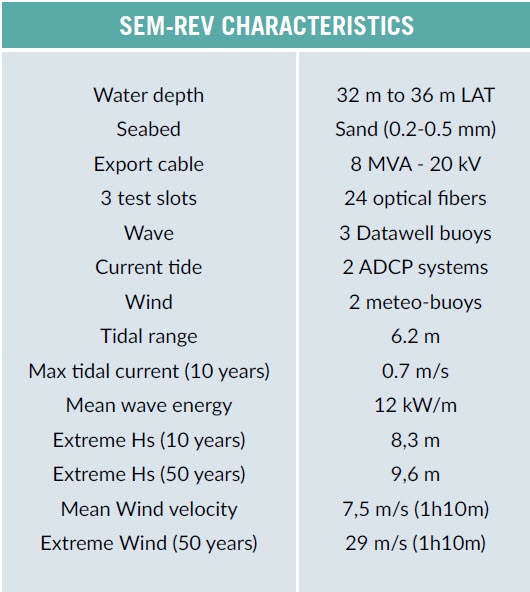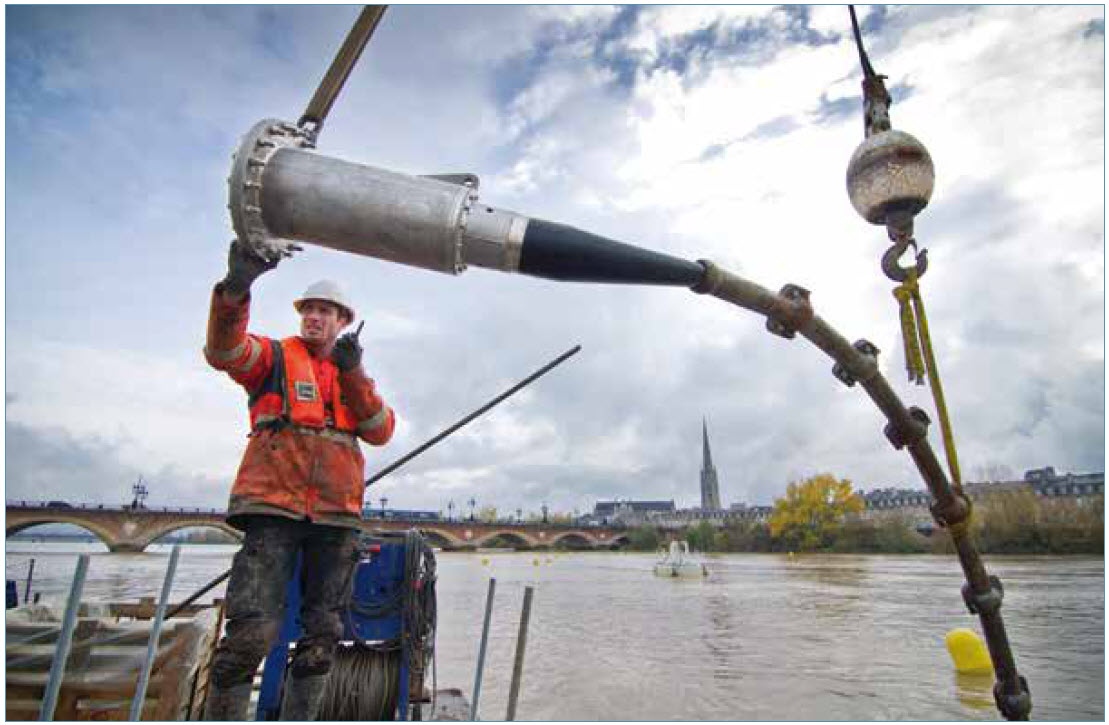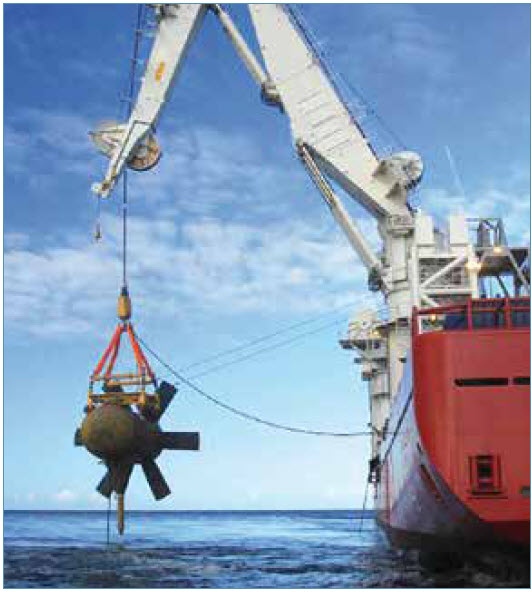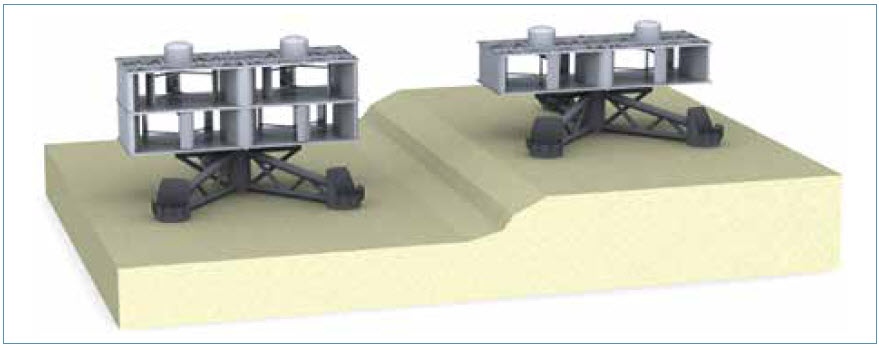FRANCE
OPEN SEA TEST SITES
|
SEM-REV The SEM-REV package includes: land station, research centre and electrical substation, export cable (20 kV, 8 MVA, 24 optical fibres), and a 1 km² restricted marine area equipped with met-ocean instrumentation, an electrical subsea termination unit for 3 prototype connections and fully consented slots for testing. Additional supporting facilities include: met- ocean data and analyses, design and installation verifications, maintenance in operational conditions, access to local marine stakeholders and environmental impact assessment. Projects currently deployed on the test site (2016 to 2018):
|
 |
|
|
The Interreg FORESEA project (partnership: EMEC, Smart Bay, TTI and ECN/SEM-REV) was launched in 2016 with the goal to deploy 6 MRE technology components at SEM-REV between 2016 and 2019. SEM-REV is also part of the H2020 MARINET2 project approved in 2016 and the ESFRI MARINERG-I project awaiting final decision early in 2017.
|
 |
SEENEOH
SEENEOH is an original estuarine tidal test site for full scale river and intermediate scale ocean tidal devices. In Bordeaux, during spring tides the Garonne River tidal range exceeds 5 m and current velocities can reach 3.5 m/s, while currents above 1 m/s occur approximately 80% of the time. Depth at the test area is greater than 8 m. These characteristics allow the testing of full and/or intermediate scale machines relevant for the extensive global tidal market in rivers, estuaries and oceans.
Each of the three available berths is connected to an onshore substation. The berths are designed to accommodate tidal devices with either mounted or floating fixation types. The grid connection has a total capacity of 250 kW. Two berths have been operational since December 2016, and the third will be in February 2017.
The services offered by the SEENEOH test site to users comprise several elements, including the provision of a technical room in the land-based converter station for the installation of the user’s energy conversion system, and monitoring of the prototype during the test campaign via a SCADA system.
OPERATIONAL PROJECTS
|
SABELLA
|
 |
HYDROQUEST
Hydroquest designs, manufactures and installs innovative hydrokinetic water turbine farms for rivers, estuaries and oceans, based on an internationally patented unique crossflow technology. Hydroquest River 1.40 is the only grid connected fluvial hydrokinetic turbine in operation in France (2 years). For commercial-ready river applications, Hydroquest offers a range of two machines with nominal power ratings of 40 kW (Hydroquest River 1.40) and 80 kW (Hydroquest River 2.80). Projects are currently underway in France, Africa, Asia and South America.
Hydroquest River turbines can be adapted to any river profile with a minimum 2m depth. The turbines use a crossflow double vertical axis technology with an anti-debris grid system installed on the supporting structure, which deflects solid objects present in the water. The hydrokinetic turbine is fixed on a floating barge equipped with a hydraulic cylinder for positioning of the turbine in its submerged position (operation) or raised position (inspection, maintenance, transportation, production pause).
PAIMPOL-BRÉHAT TIDAL DEMONSTRATION PROJECT (BRITTANY)
EDF develops a tidal demonstration project located off the north coast of Brittany. The project involves the installation of two industrial-scale OpenHydro turbines delivering up to 1 MW power to the national grid.
- The project Phase 01 was dedicated to the test of Openhydro 16m diameter prototype “l’Arcouest” in stand-alone. This phase was achieved in 2014.
- The project Phase 02 consists of two Openhydro turbines, a subsea conversion system developed by GEEPC, an export cable of around 16 km length exporting power from the converter to an onshore substation located in the “Anse de Launay” and a connection system inter-connecting the equipments. The construction of the demonstration farm was completed in 2016, with the deployment and connection of all the equipments and the achievement of numerous functional tests. The two turbines will be recovered in 2017 for detailed inspection and maintenance, with the objective of redeploying and exporting power to the grid the same year.
- Paimpol-Bréhat will also host a Hydroquest prototype for a test at sea in stand-alone.
GUINARD ENERGIES
In 2016, Guinard Energies successfully deployed its Poseide on site power measurement device based on the Mega-WattBlue design in the waters off Guyana. The MegaWattBlue technology doubles the recoverable energy for a given rotor size thanks to a specific shroud and rotor coupling. In parallel, the electrical power regulation system was validated.
PLANNED DEPLOYMENTS
Normandie Hydro
Tidal turbine pilot farm coordinated by the ADEME and financed by the Investments for the Future programme: Following the conception stage (2015), the Normandie Hydro tidal turbine pilot farm project located in the Raz Blanchard tidal race is progressing through the construction and installation stage (2016-2018). Planned for a 20-year period of operation, the 14 MW farm of 7 OpenHydro tidal turbines is coordinated by DCNS in cooperation with the French electricity provider EDF.
Guinard Energies
In 2017, the 250 kW MegaWattBlue tidal demonstration turbine will be deployed in the Ria d’Etel (South Brittany). This 4 m diameter, free-slewing ducted turbine will be commissioned using the patented “Camel” self-floating/ballasting gravity base.
OceanQuest project
HYDROQUEST and CMN, together with the University of Caen Normandy, were awarded funding in February 2016 from the Offshore Renewable Energy call for projects supported by the ADEME and Future Investments programme.
The winning OceanQuest project will install a Hydroquest demonstrator turbine with a capacity of 1 MW on the Paimpol- Bréhat EDF test site in autumn 2017.




